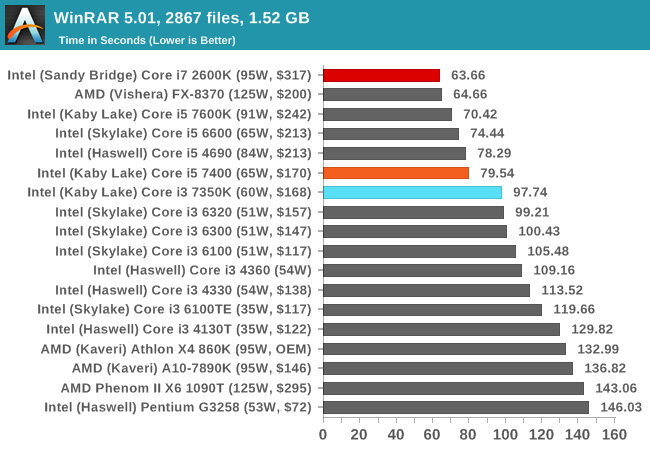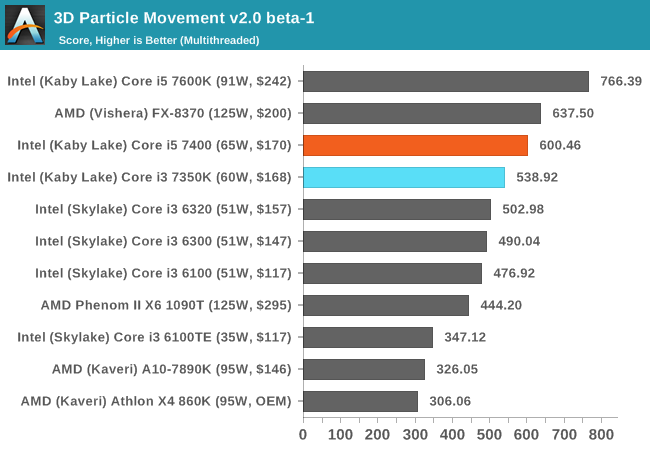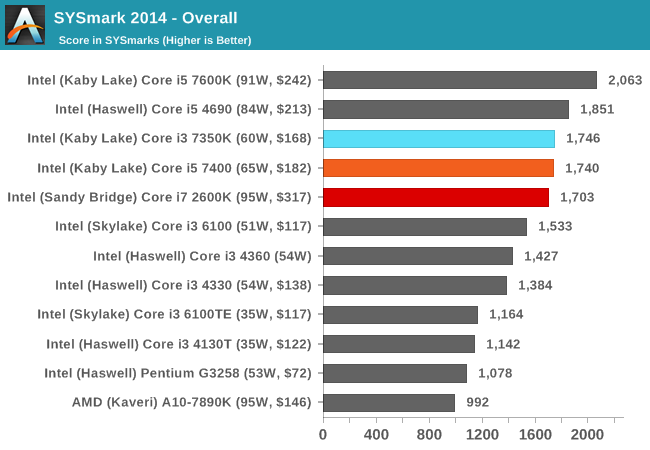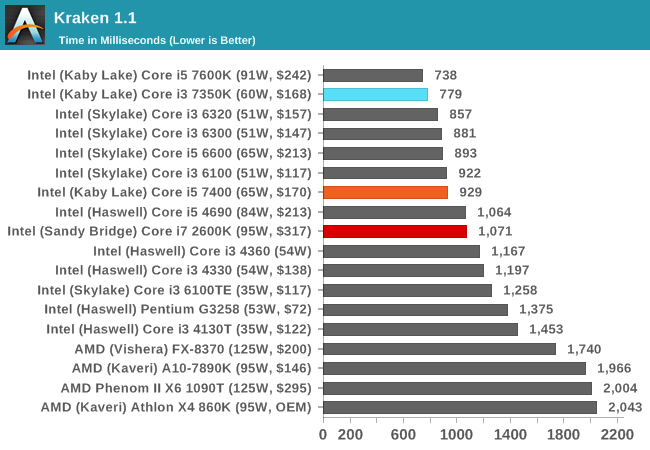The Intel Core i3-7350K (60W) Review: Almost a Core i7-2600K
by Ian Cutress on February 3, 2017 8:00 AM ESTOffice Performance
The dynamics of CPU Turbo modes, both Intel and AMD, can cause concern during environments with a variable threaded workload. There is also an added issue of the motherboard remaining consistent, depending on how the motherboard manufacturer wants to add in their own boosting technologies over the ones that Intel would prefer they used. In order to remain consistent, we implement an OS-level unique high-performance mode on all the CPUs we test which should override any motherboard manufacturer performance mode.
All of our benchmark results can also be found in our benchmark engine, Bench.
Dolphin Benchmark: link
Many emulators are often bound by single thread CPU performance, and general reports tended to suggest that Haswell provided a significant boost to emulator performance. This benchmark runs a Wii program that ray traces a complex 3D scene inside the Dolphin Wii emulator. Performance on this benchmark is a good proxy of the speed of Dolphin CPU emulation, which is an intensive single core task using most aspects of a CPU. Results are given in minutes, where the Wii itself scores 17.53 minutes.

The 7350K, with a high single thread frequency, easily surpasses the i5 and i7-2600K here. That being said, there's a slight difference to the Skylake i3, perhaps down to various generation specific code differences.
WinRAR 5.0.1: link
Our WinRAR test from 2013 is updated to the latest version of WinRAR at the start of 2014. We compress a set of 2867 files across 320 folders totaling 1.52 GB in size – 95% of these files are small typical website files, and the rest (90% of the size) are small 30 second 720p videos.

WinRAR is more geared towards a variable threaded environment but also memory speed. The fact that the Core i5 is above the Core i3 shows that having actual cores helps, regardless of frequency - the additional hyperthreads for the Core i7-2600K also gives it the win, despite the memory frequency difference.
3D Particle Movement v2
3DPM is a self-penned benchmark, taking basic 3D movement algorithms used in Brownian Motion simulations and testing them for speed. High floating point performance, MHz and IPC wins the day. This is the second variant of this benchmark, fixing for false sharing in the first version, and lending itself to better multithreaded performance.

3DPMv2 is still new, so we don’t have too many results for it so far - but again this is another situation where having actual cores helps. This is typically when the threads are 'heavy', i.e. spill out into various caches and require more than 1/2 the cache shared within a core each. In the case of the Kaby Lake, this means that each core has 32KB of L1 - or 32KB per thread for the i5 but only 16KB per thread in the i3.
SYSMark 2014
Engineered by BAPco (to which Intel is a consortium member), this set of tests are designed to be an office/data/media/financial range of tests using common well-known CAD, image editing, web browsing and other tools to put out a score, where a score of 1000 is attributed to an old Core i3 using a mechanical harddrive. Here we report the overall score, however the test breakdowns can be found in Bench.

Because SYSMark is a variety of tests that rely on response and throughput, here is where the Core i3 comes into play over the i5 and i7-2600K. With the i5 it's about equal, but the years of IPC increases put the i7-2600K now behind the Kaby i3.
Web Benchmarks
On the lower end processors, general usability is a big factor of experience, especially as we move into the HTML5 era of web browsing. For our web benchmarks, we take well-known tests with Chrome as installed by SYSMark as a consistent browser.
Mozilla Kraken 1.1

Kraken favors high frequency and IPC, so the i3 takes a large lead over the i7-2600K for this sort of workload.










186 Comments
View All Comments
realneil - Wednesday, February 8, 2017 - link
^^This^^Intel is ~finally~ facing some upcoming opposition in the CPU arena and they're trying to fill in some perceived gaps in their CPU lineup.
After Ryzen is released, expect to see multiple product changes from team blue right away to combat AMD's offerings.
CaedenV - Friday, February 3, 2017 - link
I think it will make more sense with next gen parts. I suspect we are watching a shift in the lineup that is slowly rolling out.celeron - duel core
pentium - entry duel core with HT (limited cache/clock/iGPU)
i3 - high-end duel core HT (essentially unchanged)
i5 - quad core with HT (today's i7)
i7 - 6-12 core with HT (today's LGA2011 line)
So why no straight quad core part? Well, 2 reasons.
1) it probably isn't needed. The original i5 parts were just i7s with broken HT cores that were disabled. I imagine most chips coming out now have perfectly fine HT cores, so they are artificially disabled. This increases the cost of the binning process, and reduces profit on a per-chip basis... especially if they can sell the same part somewhere between today's i5 and i7 price.
2) Right now I would wager that most home builders buy either an i3 because they are budget conscious, or i7 because their pride will not let them get anything less than the best. But the i7 that they buy is the lower margin 'consumer' i7 chips rather than the premium laiden LGA2011 i7 chips that make buku bucks on both CPU and chipset sales. Moving the i7 lineup to start at ~$500 instead of ~$280 would more than off-set the number of people willing to step down to an i5 chip; even if the step down is in name only and really the i5 would be more affordable while offering traditionally i7 performance levels.
3) Bonus reason; Ryzen chips are expected to land near today's i5/i7 chips in performance, and Intel does not want AMD to be able to say 'our chips are as fast as an i7 but only cost what an i5 does'. Instead, intel want's it's smug users (like myself) to say 'ya, that Ryzen is not a bad chip, but it doesn't hold a candle to my i7'. Real world benchmarks be damned, it is what people are going to say.
Alexvrb - Friday, February 3, 2017 - link
I wouldn't necessarily bet that more home users buy i7s than i5s. I personally know two gamers that recently built i5 systems because they wanted more oomph than a 2C/4T i3, but didn't want to spend money on an i7. Why? So they could spend more money where it makes the biggest difference... the graphics card. An i5 provides plenty of CPU horsepower for games, and gives you another $100 or so to spend on better graphics.I think their judgement was sound. I doubt they are alone in this kind of assessment. I think you're letting your admitted i7 smugness cloud your judgement a little bit.
Tunnah - Saturday, February 4, 2017 - link
I build PCs for my friends, and advise people on what to buy, and I don't know a single person apart from myself who has an i7 (and only know of 1 person who has an i3 but he uses his box for media). i5 is a perfect chip for casual users who use the PC mostly to game.Hell the only reason I have an i7 is for Civ VI ha.
Alexvrb - Saturday, February 4, 2017 - link
Bingo!Meteor2 - Sunday, February 5, 2017 - link
i7s (or Xeons) are nice if you're encoding a lot of x265 video (x265 gives better quality per bitrate than hardware encoders). That's the only desktop use case I can think of.Meteor2 - Sunday, February 5, 2017 - link
...or apparently not, according to a comment way below, where a 12C/24T Xeon barely does double digit x265 FPS.bak0n - Monday, February 6, 2017 - link
Exactly why I have an I5 3570k. My next build will either be a ryzen (depending on wither it hits expectations), or the I5 of whatever generation is out when I'm ready to buy. To big of a price jump to the I7 for a hard core 1080P maxed setting gamer, but not to much of a price jump over the i3's. That is, until now with the i3k which I may actually give a second look at.DiHydro - Monday, February 6, 2017 - link
I fit into that category with one caveat, I also do some 3d modeling and rendering. This pushed me to the i7-2600k about four years ago, and I still don't feel that my CPU is the limiting factor on my PC.Byte - Saturday, February 4, 2017 - link
Very true, most customers want the best or the cheapest. Changing the lineup liek that would make it easier.